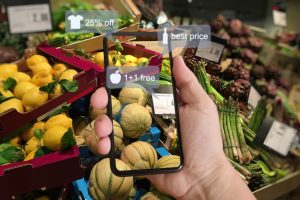The e-commerce industry is always changing and this year has been no different. More than ever, merchants are creating and/or improving their e-commerce businesses to meet customers where they are. While it may seem like everything in e-commerce is evolving, we narrowed it down to the biggest trends that will affect businesses in the coming months and years.
We spoke with leaders in the industry about the changes this year and they had a lot to share. So, let’s explore the biggest e-commerce trends and see where things are headed.
- AR enhances the reality of online shopping.
- There will be a growing volume of voice searches.
- AI helps shops learn about shoppers.
- On-site personalization uses those insights to create individualized experiences.
- Big data plays a big part in creating personalized experiences.
1. Augmented reality enhances the reality of online shopping.
Augmented reality (AR) has been a complete game-changer for e-commerce. With this type of technology, shoppers can truly see the item they’re shopping for, which helps them make a buying decision. AR really changes the shopping experience in specific industries, such as fashion and home decor because the customer can get a better feel for the item without seeing it in person.
In 2019, Gartner predicted that 100 million consumers will shop using AR by 2020, so it will be interesting to see how that shakes out next year.
Michael Prusich, Director of Business Development at 1Digital Agency, agrees with this prediction:
“Polls have shown some really powerful numbers in regards to AR too: 35% of people say that they would be shopping online more if they could virtually try on a product before buying it, and 22% would be less likely to visit a brick-and-mortar store if AR was available via their favorite e-commerce store. AR grants a person the ability to not just see a 3D model of a product but lets a user see how it looks if they were actually wearing it. Some products and industries lend themself better to traditional shopping methods, but AR is going to shake things up sooner than later.”
Tessa Wuertz, Director of Marketing & Partnerships, efelle.com, also sees the potential for even smaller to mid-market businesses joining the trend:
“We are expecting a lot more businesses to utilize AR for their products and businesses — so much so that it will become more standard in e-commerce and social media platforms. We’re seeing it put to use with larger companies, but I think we’re soon going to start seeing it become mainstream for businesses of all sizes.”

2. There will be a growing volume of voice searches.
Not only do more people own smart speakers, but they also rely on voice assistants to complete daily tasks. Loop Ventures forecasts that 75% of U.S. households will own a smart speaker by 2025.
As more homes adopt smart speakers, more consumers will utilize voice search to shop online, order food, and organize their lives. The rise of voice search creates an opportunity for e-commerce businesses in terms of keywords and content.
David Zimmerman, Director of eCommerce Solutions, Kensium, included “more involvement of voice-enabled solutions in the commerce space with Amazon Alexa and Google Home” high on his list of 2020 trends to keep an eye on.

3. AI helps shops learn about shoppers.
Artificial Intelligence (AI) and machine learning make it possible for the customer to have automated, personalized shopping experiences. AI is continuously collecting data on how a customer shops, when they buy purchases and what they’re looking for in a product or a service. It’s a piece of technology that really can’t be replicated in-store.
Ron Smith, Editor in Chief, The Digital Outdoor, emphasizes how the complexity of AI and the ability to make it more human is also increasingly important:
“People want to know that brands care about them, and AI will be programmed accordingly. We have currently seen the opposite behavior on social media, where AIs learn from humans’ more negative remarks, but it’s highly likely that consumers will crave the impact. If bots can learn how to form sentences to convey an emotion, companies can soon teach them to offer comfort and products based on customers’ moods.”
4. On-site personalization uses those insights to create individualized experiences.
Buyers of all sorts — including B2C and B2B — are looking for personalized, custom shopping experiences online. The data collected from AI is what makes it possible for a buyer to get personalized product recommendations and detailed customer service.
Implementing personalized experiences on-site or in marketing efforts has been shown to have a strong effect on revenue, with one study finding it had a 25% revenue lift for retailers scaling advanced personalization capabilities.
For further context, this accounted for 19% of participating companies while retailers that were “building basic personalization capabilities” achieved “a revenue lift of 10% or more; the retailers in this tier account for 40% of the participating companies.
Kaleigh Moore, freelance writer and e-commerce specialist, sees AI-powered personalization becoming increasingly relevant in 2020:
“As brands harness and leverage more data, they’ll be able to create incredibly relevant experiences for shoppers that feel tailor-made.”
5. Big Data Plays a role in creating personalized experiences.
Today, many consumers are more aware that e-commerce sites are collecting personal data, which puts them at risk. Because of this, experts have mixed feelings about the benefits of big data and how it affects the personalized shopping experience.
Luis Carter, a Conversion Rate Optimization Expert at Kensium Solutions, has his own predictions for how personalization will continue to evolve alongside data concerns:
“As the tech giants continue to expand and bring more services in-house, personalization will eventually make its way to the internet of things. In addition to seeing suggestions on search engines or shopping platforms, we’ll also see them on our thermostats and our doorbell cameras. However, with some of the legislation being enacted, we’ll be able to opt-out of it. This will create an interesting dichotomy — people who have ultra-personalized experiences and those who do not. This will have interesting impacts on how we as marketers are able to reach new users.”



